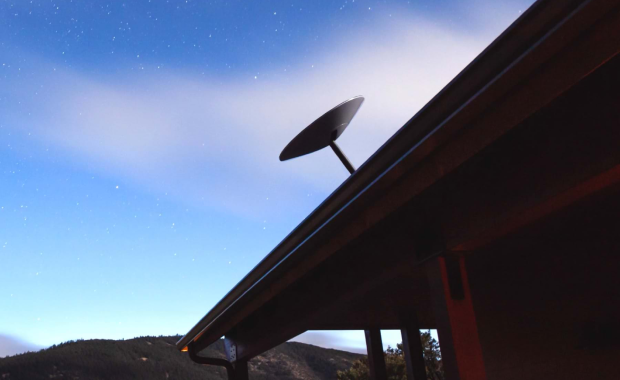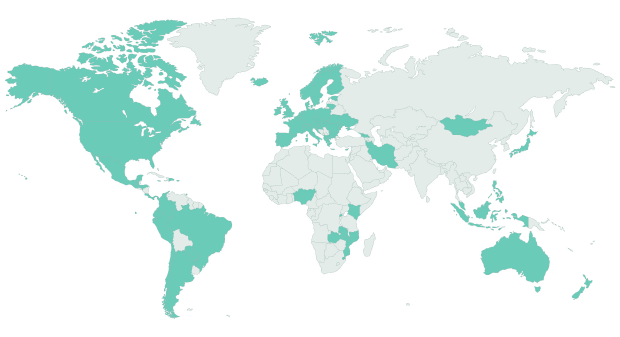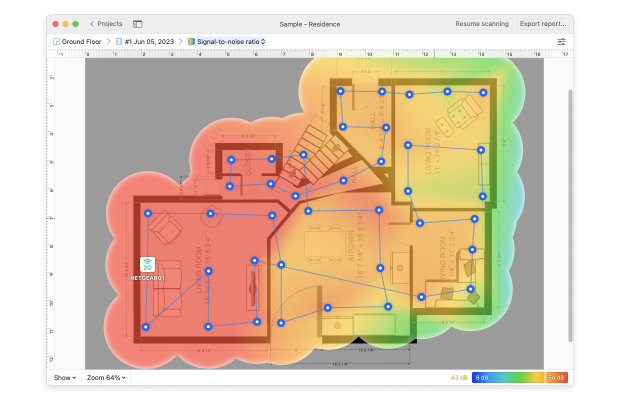Wi-Fi Site Surveys, Analysis, Troubleshooting runs on a MacBook (macOS 11+) or any laptop (Windows 7/8/10/11) with a standard 802.11be/ax/ac/n/g/a/b wireless network adapter. Read more about the 802.11be support here.
Starlink Internet Review: Is Elon’s Satellite Internet Worth It?
Elon Musk is known mainly for ushering in the electric car revolution and launching advanced rockets into space. What many people don’t know is that the billionaire entrepreneur is also behind one of the fasted-growing internet providers in the world, Starlink.
It can be tempting to dismiss Starlink as yet another satellite internet service like Viasat and HughesNet. That, however, would be a huge mistake because Starlink relies on a massive satellite constellation and low-Earth orbit technology to deliver a fiber-like experience to increasingly many parts of the world.
Starlink Internet Plans and Pricing
The table below lists all Starlink internet plans that are available at the time of writing this review:
| Plan | Standard |
| Download speed | 25-100 Mbps |
| Latency | 25-60 ms |
| Price | $120.00 per month |
| One-time hardware cost | $599 |
| Data cap | Unlimited |
| Plan | Priority |
| Download speed | 40-220 Mbps |
| Latency | 25-60 ms |
| Price | From $140 per month |
| One-time hardware cost | $2,500 |
| Data cap | Unlimited standard data |
| Plan | Mobile |
| Download speed | 5-50 Mbps |
| Latency | |
| Price | $150 for regional access or $200 for global access |
| One-time hardware cost | $599 |
| Data cap | Unlimited mobile data inland |
| Plan | Mobile Priority |
| Download speed | 40-220 Mbps |
| Latency | |
| Price | From $250 per month |
| One-time hardware cost | $2,500 |
| Data cap | Unlimited mobile global data inland |
Starlink offers four plans, and each plan targets a different market segment. Most customers who live in remote areas and are looking for a reliable internet service will be interested in the residential Standard plan, which costs $120.00 per month and requires a one-time purchase of a Starlink base station for $599.
Those who want more bandwidth than what the Standard plan offers (up to 100 Mbps) can go with the Priority plan instead to get download speeds of up to 220 Mbps. The Starlink Priority plan can be yours from $140 a month and requires a beefier and more expensive base station (a one-time purchase of $2,500).
People who live or frequently travel in RVs can get the Starlink Mobile plan for $150 per month (+ a $599 base station) for the regional variant or $200 a month for the global variant. Finally, Starlink has a plan aimed at everyone from merchant vessels to oil rigs to premium yachts. The Starlink Mobile Priority plan starts at $250 a month, and it requires a $2,500 base station.
While the Standard plan provides unlimited high-speed, low-latency internet without any data caps, the Priority and Mobile Priority plans introduce a specific amount of Priority Data — 40 GB starting at $140/month, 1 TB at $250/month, and 2 TB at $500/month for Priority plans. After the Priority Data is exhausted, the service throttles to standard speeds, ensuring users still have internet access. Additional Priority Data can be purchased as needed.
Similarly, Mobile Priority plans start with options ranging from 50 GB at $250/month to 5 TB at $5,000/month, also throttling to standard speeds post allotment and offering the possibility to buy more Priority Data.

Compared with its closest satellite competitors, Viasat and HughesNet, whose speeds are five or six times slower, Starlink offers a much better user experience, and the huge rate at which its already sizable constellation of satellites is expanding means that it will only keep getting better and better.
Note: Subaru Starlink in-vehicle technology has nothing to do with Elon Musk’s Starlink internet service.
Starlink Internet Coverage
Starlink satellite internet services are available in the following locations:
| Continent | Countries/Territories with Starlink Availability |
| Americas | United States, Puerto Rico, United States Virgin Islands, Guam, Northern Mariana Islands, Canada, Chile, Easter Island, Brazil, Mexico, Dominican Republic, Colombia, Jamaica, Barbados, Peru, Ecuador, El Salvador, Panama, Trinidad and Tobago, Guatemala, Bahamas, Costa Rica, Honduras, Paraguay, Argentin |
| Europes | United Kingdom, Pitcairn Islands, Germany, France, Saint Martin, Saint Barthélemy, Guadeloupe, Martinique, Austria, Netherlands, Belgium, Ireland, Denmark, Portugal, Switzerland, Poland, Italy, Czech Republic, Sweden, Croatia, Lithuania, Spain, Slovakia, Slovenia, Bulgaria, Ukraine, Romania, Greece, Latvia, Hungary, North Macedonia, Luxembourg, Moldova, Estonia, Norway, Malta, Cyprus, Finland, Georgia, Albania |
| Asia | Iran, Japan, Philippines, Malaysia, Maldives, Mongolia |
| Africa | Nigeria, Mozambique, Rwanda, Kenya, Malawi, Zambia, Benin, Eswatini |
| Oceania | New Zealand, Australia, Tonga |
You can check the Starlink internet availability map to see where exactly the satellite internet service is currently available.

Starlink currently has over 6,000 mass-produced small satellites in low Earth orbit, which together provide access to over 2.6 million subscribers, up from just 100,000 in 2021.
The rapid expansion of Starlink's satellite internet service, as illustrated by its availability across multiple continents and a wide array of countries, is a testament to the high demand for reliable internet services worldwide and to the attractiveness of Starlink's offering.
As Starlink continues to deploy more satellites and gain regulatory approval in additional territories, its potential to connect the world like never before grows ever more evident.
Starlink Internet Fees & Bonuses
Starlink keeps things nice and simple by not requiring customers to sign a long-term contract — a practice most other satellite internet service providers seem to love.
The only extra expense you need to keep in mind is the cost of the Starlink dish and router combo, which starts at $599 and goes all the way up to $2,500, depending on which plan you choose.
The latest (third) generation of the Starlink WiFi router marks a substantial upgrade in Starlink's hardware lineup because it integrates Wi-Fi 6 (802.11ax) technology for improved efficiency and enhanced ability to connect a large number of client devices. A notable design tweak is the addition of two Ethernet ports, hidden under a removable panel, which are great for reliably connecting devices like TVs, video game consoles, and computers.
If you decide to go this route, then we highly recommend you use a wireless network analyzer like NetSpot to optimize the placement and configuration of your router to achieve the best performance and coverage possible.

Just like the Starlink satellite internet service, NetSpot is designed to deliver a fantastic user experience, allowing even regular home users with no expert IT skills to achieve great results.
Starlink Customer Service & Satisfaction
Most traditional internet service providers give their customers multiple options on how to contact customer service — but not Starlink.
On its website, you won’t find any Starlink customer service phone number or email address. In fact, Starlink customer service can only be reached using the official mobile app (available for Android and iOS). This method aligns with the tech-savvy nature of Starlink's customer base but has also been a point of contention for users accustomed to multiple avenues of support.
Indeed, the poor availability of Starlink’s customer service is reflected in many Starlink reviews published on websites like Trustpilot and ProductReview.com.au by real users. There, it is common to find complaints about the lack of responsiveness and the difficulty in reaching a human representative for assistance.
Starlink users also often complain about the results of Starlink speed tests being much lower than the speeds the satellite internet provider advertises on its website. To be fair, such complains are common with satellite internet in general, as it is strongly influenced by various external factors such as weather conditions, obstructions, and the positioning of the satellite dish.
Here are just three Starlink internet reviews that were recently published on Trustpilot
Summary
Starlink internet promises a next-generation satellite internet experience with fiber-like speeds (there’s no Starlink fiber internet) and no download/upload limits.
The actual experience can be a hit or miss, depending on your geographic location, the placement of the Starlike base station, and even the configuration of your WiFi router.
The good news is that Starlink offers a 30-day money-back guarantee, so the initial Starlink internet cost is easier to swallow.
Starlink Internet — FAQs
As of 2023, the national average internet speed in the U.S. is 171.30 Mbps, according to HighSpeedInternet.com's internet speed test. Starlink promises speeds of up to 220 Mbps, but users may experience significant speed fluctuations, resulting in an average speed that is lower than the maximum achievable speed. Nonetheless, Starlink generally provides faster internet speeds than traditional satellite internet service providers like Viasat and HughesNet.
Starlink offers a satellite internet service backed by a growing network of low-Earth orbit satellites. It’s a great option for people who live in remote areas where DSL and fiber internet isn’t available, but it doesn’t make sense for people who live in cities and other places where traditional internet providers operate.
Starlink offers multiple internet plans with varying prices and features. The Standard plan starts at $120 a month, with a one-time hardware cost of $599 for the necessary satellite dish and router. Other plans include Priority, Mobile, and Mobile Priority, with prices ranging from $140 per month to $5,000 per month.
You can check your Starlink coverage using the official coverage map.
